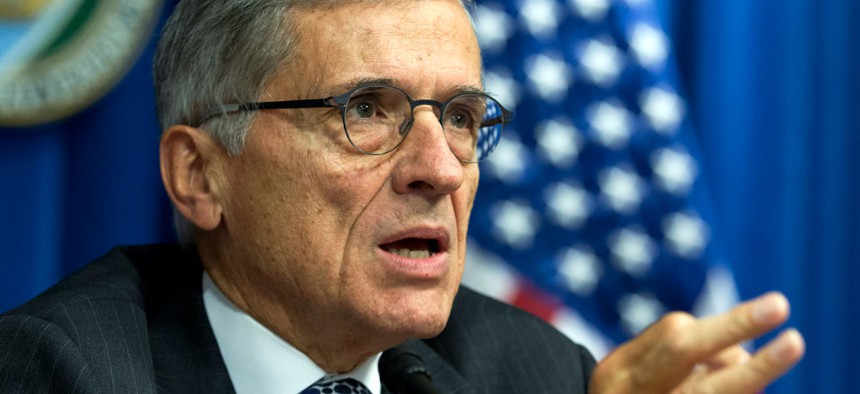FCC Finally Unveils Net-Neutrality Rules

FCC Chairman Tom Wheeler Jose Luis Magana/AP
The next step is the Federal Register—then federal court.
Two weeks after approving sweeping net-neutrality regulations, the Federal Communications Commission has finally made those rules public.
The full document is 400 pages long, although that includes statements from the five commissioners, as well as legal and policy analysis by the FCC staff. The actual rules themselves take up only eight pages.
The FCC had already publicly outlined the main elements of the regulations, but advocates on all sides of the debate have been eagerly awaiting the actual text in order to pick apart the details. Lawyers for the broadband industry in particular have been waiting to see the FCC's language so they can begin preparing their lawsuits. The major providers, like Comcast and AT&T, have all said they expect a flurry of litigation (although no company has actually committed to suing yet).
The White House's Office of Management and Budget will have to sign off on certain elements of the regulations, which will then be published in the Federal Register. They officially go into effect 60 days after that.
The rules are designed to prevent Internet providers from acting as "gatekeepers" and controlling what information people can access online. The regulations bar providers from blocking online content, selectively slowing down any traffic, or creating any special "fast lanes" for sites that pay more. The rules apply to Internet connections both at home and on mobile devices.
In an attempt to ensure the regulations can hold up in court, the FCC declared broadband Internet a "telecommunications service" under Title II of the Communications Act. The provision, which the agency has long used to regulate landline telephones, grants the agency broad powers over the industry. The broadband providers fear the step has turned them into heavily regulated public utilities.
Here are the core sections of the rules:
§ 8.5 No blocking.
A person engaged in the provision of broadband Internet access service, insofar as such person is so engaged, shall not block lawful content, applications, services, or non-harmful devices, subject to reasonable network management.
§ 8.7 No throttling.
A person engaged in the provision of broadband Internet access service, insofar as such person is so engaged, shall not impair or degrade lawful Internet traffic on the basis of Internet content, application, or service, or use of a non-harmful device, subject to reasonable network management.
§ 8.9 No paid prioritization.
(a) A person engaged in the provision of broadband Internet access service, insofar as such person is so engaged, shall not engage in paid prioritization.
(b) "Paid prioritization" refers to the management of a broadband provider's network to directly or indirectly favor some traffic over other traffic, including through use of techniques such as traffic shaping, prioritization, resource reservation, or other forms of preferential traffic management, either (a) in exchange for consideration (monetary or otherwise) from a third party, or (b) to benefit an affiliated entity.
(c) The Commission may waive the ban on paid prioritization only if the petitioner demonstrates that the practice would provide some significant public interest benefit and would not harm the open nature of the Internet.
§ 8.11 No unreasonable interference or unreasonable disadvantage standard for Internet conduct.
Any person engaged in the provision of broadband Internet access service, insofar as such person is so engaged, shall not unreasonably interfere with or unreasonably disadvantage (i) end users' ability to select, access, and use broadband Internet access service or the lawful Internet content, applications, services, or devices of their choice, or (ii) edge providers' ability to make lawful content, applications, services, or devices available to end users. Reasonable network management shall not be considered a violation of this rule.



